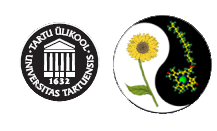 English
English Eesti
Eesti
Barochromic (pressure-dependent) studies of electronic excited states
The manner photosynthetic organisms, plants, algae, and bacteria, harvest solar energy and adjust spectrally to environmental extremes has been of considerable long time interest. Apart from fundamental curiosity, the main driving force behind this steady attention is the possibility of finding useful bio-mimetic principles for future energy conversion technology. The energetic and dynamic properties of the chromoproteins depend on couplings between the pigments and pigment-protein interactions. In order to adequately understand this complicated set of interactions, simpler model systems should be studied under the conditions where various relevant couplings could be tuned in controllable manner over a sufficiently wide range. In many cases, applying external high pressure provides such an option. As experiments show, the pressures in 10 kbar scale typically result in about 1/3 volume reduction of soft macromolecules such as proteins or polymer globules. The mechanical perturbations so created are sufficient to break the hydrogen bonds. We plan to use the high-pressure technique for (i) studying the couplings between the biologically relevant chromophores (including porphyrines, phtalocyanines, chlorophylls, carotenoids, and hemes) and their respective solvent molecules; (ii) exploring the inter-chromophore couplings in dimers and simple oligomeric aggregates; (iii) investigating the pressure-induced tuning of singlet and triplet energy levels. Dimers are the simplest molecular aggregates. They are recognized as the elementary building blocks in many photosynthetic light-harvesting antennas. A phtalocyanine dimer complex, LuPc-2, was chosen for our detailed studies because of its clear-cut absorption spectrum in the visible range. Phtalocyanines are also among the most promising molecules for building artificial light harvesting antennas. The subject (iii) is related to the singlet fission (SF) process, which occurs in some molecular systems (certain conjugated polymers, e.g.). In analogy to the multiple exciton generation in quantum dotss, also the SF can drastically improve the solar cell performance via lifting the 30% efficiency limit of single-junction solar cells. The physics behind SF is not understood. However, obviously the energy of the triplet state has to be close to the half of the singlet state. In the search for efficient SF molecules synthesis groups try to make such molecules. In this project we use the fact that the triplet and singlet energy levels have different pressure dependence. In this way we can, by using pressure, tune prospective molecules to the "right" energy and study the possible SF.
